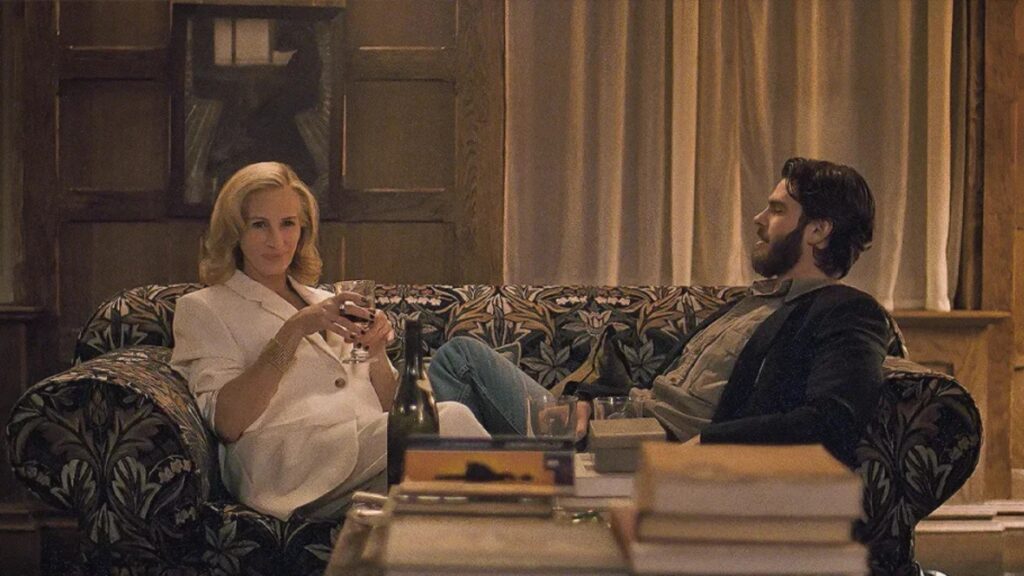Basic Info & Context
- After the Hunt is a 2025 psychological drama-thriller directed by Luca Guadagnino and written by Nora Garrett.
- Runtime: ~139 minutes.
- Country: United States / Italy. Language: English.
- Budget: reported at US$70-80 million.
- Worldwide theatrical gross: approximately US$8 million.
- The film had its world premiere out of competition at the 82nd Venice International Film Festival on August 29, 2025.
This is a major departure from purely commercial fare — a prestige, adult-oriented film with serious themes involving power, academia, sexual misconduct, and secrets.
Cast & “Means Character” of After the Hunt Movie.
Principal Cast
- Julia Roberts as Alma Imhoff, a respected professor at Yale University.
- Ayo Edebiri as Maggie Resnick, the star student/protégé of Alma who makes a serious accusation.
- Andrew Garfield as Hank Gibson, Alma’s longtime colleague and friend who faces the accusation.
- Michael Stuhlbarg as Frederik Mendelssohn, Alma’s psychiatrist husband.
- Chloë Sevigny as Dr. Kim Sayers, a university administrator and part of the power dynamic.
- Additional supporting cast: Thaddea Graham (Katie), Lío Mehiel (Alex), Will Price (Arthur), etc.
Counting the main ensemble and significant supporting roles, you’re likely looking at around 10-15 credited cast members who carry major screen time and narrative weight.
Means Character
The story is told primarily through the lens of Alma Imhoff (Julia Roberts). The audience follows Alma’s professional world, her domestic life, the crisis triggered by the student accusation, and her past secrets coming to light. While both Maggie and Hank have strong arcs, Alma is the vantage point: her decisions, her moral conflict, her stability (or lack thereof) drive the narrative forward. In that sense, Alma is the “means character.”
Box Office & Commercial Performance.
- Budget: ~$70-80 million.
- Worldwide gross: ~US$8 million according to public sources.
- Rotten Tomatoes reports a 38% Tomatometer (199 reviews) with commentary about performances, but critical reception is mixed.
In short — the After the Hunt film had a strong prestige positioning (festival premiere, star power, major director) but did not achieve a large commercial box office return by theatrical standards. With its budget and expectation, the numbers suggest this is more of a prestige/awards play than blockbuster fare.
Niche, Tone & Thematic Domain.
Genre / Niche
After the Hunt sits in the psychological thriller / campus drama / adult moral crisis niche. It joins films about academia, power dynamics, sexual misconduct, and reputational crisis (think The Hunt, Oleanna), but with the style of a director like Guadagnino: composed, visually rich, layered rather than direct. It’s not a mass-market “thriller” in the usual sense (car chases, bombs) — it’s cerebral, morally vexed, institutional.
Tone & Themes
The tone is tense, quietly unsettling, and morally ambiguous. The themes include:
- Power, privilege and academia: A venerable professor at Yale, her star student, her male colleague — the film interrogates who holds power and how accusations shift dynamics.
- Sexual misconduct and the #MeToo era: The plot hinges on a faculty member being accused by a student — immediately suggestive of contemporary culture, complicity, institutional failure.
- Truth, perception and secrecy: Alma has a “dark secret from her past” which threatens everything. The film asks how memory, loyalties, and truth intersect.
- Loyalty, betrayal, friendship, career: Alma and Hank are longtime friends; Maggie is the protégé; the triangulation is ripe for tension.
- Private/domestic vs public/professional selves: Alma’s domestic life (vaccum, husband, reputation) versus her public persona is a recurring motif.
This niche and tone make the film aimed at viewers seeking layered drama, moral complexity, intense performances, rather than conventional suspense/horror or broad comedy.

Narrative & Deep Details.
Here’s a deeper dive into the story, structure, key scenes and what makes the film tick (spoiler-aware but not full reveal):
Setup
Alma Imhoff is a tenured philosophy professor at Yale. She’s respected, admired, and her life seems in order: a stable marriage with Frederik, intellectual prestige, and a promising protégé in Maggie Resnick. Then Maggie accuses Alma’s colleague Hank Gibson of sexual assault. The accusation rattles the department, triggers institutional investigation, and forces Alma into a moral corner: does she stand with her friend Hank, stand with Maggie, or try to protect her own standing? Meanwhile, Alma’s past is quietly emerging — a secret she buried that may undermine her moral authority.
Build
From here the film enters a tension-ridden middle: Alma juggling faculty meetings, departmental politics, the investigation against Hank, press whispers, and interactions with Maggie that vary between condescension and guilt. Hank’s career is at risk; Alma must choose sides. Maggie’s status as a star student complicates things. Meanwhile Alma’s domestic world — her husband Frederik, her personal history — starts to leak. She attends dinners, lectures, late-night conversations, and scenes where she rehearses her public posture while privately unraveling. Guadagnino’s camera lingers: there are long takes in offices, shots of Alma’s eyes, shots of empty halls at Yale that suggest isolation.
Climax
The crisis comes when Alma’s secret surfaces (without giving full detail): her ability to mentor Maggie is questioned, her relationship with Hank is exposed, and the institutional system forces decisions. Alma must confront not only the surface accusation but also her own complicity in a culture of silence and power. This leads to a confrontation scene (in a faculty hearing or public forum) that is less about “who is guilty” than “who is responsible.” The After the Hunt film doesn’t offer a clean resolution; rather it leaves questions hanging about the nature of truth.
Resolution
In the end, Alma accepts change: her career, her reputation, her relationships may shift. Maggie may leave the university; Hank’s future is uncertain; Alma’s personal life is fractured. The final moments underscore that legacy and intellectual prestige are fragile when built on shifting sands. The After the Hunt is not an easy watch, nor is it meant to be a comforting resolution to its moral questions. film closes on ambiguous but emotionally grounded notes: Alma walking through a library corridor, the ticking of a clock in her office, the echo of a lecture hall indicating that the hunt (for truth, for career, for power) continues.
What Works & What Doesn’t
Strengths
- Star performances: Julia Roberts delivers one of her most layered roles in years. Critics highlight her ability to communicate both control and vulnerability.
- Director’s ambition: Guadagnino uses visual style (Cinematography by Malik Hassan Sayeed) and sound (score by Trent Reznor & Atticus Ross) to create a mood of slow disquiet. The setting (Yale, campus architecture) adds texture.
- Relevance of themes: In a post-#MeToo era, the film’s exploration of sexual misconduct, mentoring, power imbalances and institutional complicity feels timely. Interviews with writer Nora Garrett emphasize this.
Weaknesses
- Commercial under-performance: With an ~$70-80 million budget and ~US$8 million gross, the After the Hunt film did not reach wide audience uptake. That may affect its cultural reach.
- Critical division: While performances were praised, reviews suggest the film’s ambition outstrips its structural clarity. According to Rotten Tomatoes, the film has a low Tomatometer score (~38%).
- Pacing & ambiguity: For some viewers, the film’s slow build, ambiguous moral framing, and lack of clear resolution may feel unsatisfying. The Guardian review problems with “muddled, over-long narrative and confused characterisation.”
Why This Movie Matters.
After the Hunt matters because it’s a high-profile film dealing with serious institutional and moral issues in a way that isn’t neatly binary. It doesn’t simply declare a good guy or bad guy; it asks how systems perpetuate silence, how reputations are invested, how mentorship and hierarchy can become toxic. In a landscape of streaming, franchise films and spectacle, this is a director’s film — adult, uneasy, meant to provoke conversation.
It also matters as a vehicle for Julia Roberts in a performance that many critics consider among her best in decades — which helps the film anchor itself in public conversation even if commercial returns are modest.
From an industry standpoint, it highlights how prestige cinema — big budget yet serious theme film — still struggles commercially unless it hits critical acclaim or awards momentum. After the Hunt film may gain longer life via streaming and home release.
Final Thoughts.
After the Hunt is not an easy watch, nor is it meant to be a comforting resolution to its moral questions. It’s a film that invites discomfort — in its characters, its institutional setting, its questions of power and truth. If you want neat answers, you won’t get them here. But if you are willing to sit with ambiguity, watch performances that expose fault lines rather than hide them, and engage with questions of privilege, academia, power and sexual misconduct — this film delivers something weighty and significant.
Julia Roberts’ Alma is compelling: she is not perfect, nor entirely sympathetic, but she is human. Her world — in every polished lecture hall, every book-lined office, every late-night whispered conversation — feels real. Guadagnino’s direction elevates it beyond “just another campus drama” into something more haunting.
If you like adult cinema that challenges you rather than entertains you lightly, After the Hunt is worth your time. Its box office may disappoint, but its thematic ambition, performances and visuals offer a reward for those willing to watch closely.





